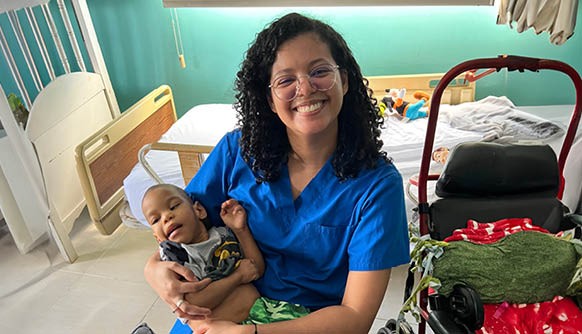News
Q&A: Causes, Challenges, and Treatments for Parkinson’s
April 3, 2024
Photo credit: American Osteopathic Association
In honor of Parkinson’s Awareness Month, we are sharing this 2023 interview with Adena Leder (D.O.’99), director of New York Tech’s Adele Smithers Parkinson’s Disease Treatment Center.
Every six minutes, a person in the United States will be diagnosed with Parkinson’s disease, a neurodegenerative disorder that affects the nervous system and the parts of the body controlled by the nerves. Approximately one million Americans today are living with Parkinson’s.
April is observed as Parkinson’s Awareness Month in honor of the birth month of James Parkinson, the London physician who first identified the disease in 1817. However, more than 200 years later, many Parkinson's patients struggle to receive an early diagnosis, which can be key to slowing further disease progression.
Experts at New York Tech’s Adele Smithers Parkinson’s Disease Treatment Center provide medical care and comprehensive rehabilitation treatments in physical, occupational, and speech therapy, as well as innovative exercise and wellness programs.
In recognition of Parkinson’s Awareness Month, New York Tech Parkinson’s Center Director Adena Leder (D.O. ’99), a neurologist and movement disorders specialist, shares important information about this neurodegenerative condition.
What are some suspected causes of Parkinson’s disease?
There is not one exact cause for Parkinson’s disease. It is likely caused by a combination of genetics and environmental exposure. Only approximately 10 to 15 percent of patients have a known genetic cause. Although more patients may have a gene, these patients have yet to be identified.
There are also several known environmental causes for Parkinson’s disease, including agent orange exposure (seen in former military personnel), as well as an industrial solvent called trichloroethylene that has widespread use. Other examples include paraquat, which is a pesticide so toxic that 32 countries, including China, have banned it, and a nerve toxin called chlorpyrifos, which is the most widely used insecticide in the United States, often on golf courses and on dozens of crops. If a patient has a genetic predisposition and is then exposed to one of these toxic chemicals, they would be at a higher risk of developing Parkinson’s disease.
In addition, head injuries are known to contribute to the development of Parkinson’s.
Why is Parkinson’s disease challenging to diagnose?
While most people generally think of shaking when it comes to Parkinson’s disease, this is not always a presenting symptom, nor is it the most disabling. There are motor symptoms, including tremors, slowing, stiffness, and gait imbalance. There are also non-motor symptoms, which include mood changes (depression and anxiety), loss of smell, and constipation, just to name a few. Loss of smell can begin more than 10 years prior to a diagnosis. Sleep disorders can also present years before a Parkinson’s diagnosis.
When the patient presents without a tremor, or if it is a younger patient, then the diagnosis can be easily missed. Young-onset women with Parkinson’s disease generally report that they are seen by approximately five doctors before a diagnosis is made. It is crucial to make the diagnosis early in order for the patient to start treatment.
The most important part of treating Parkinson’s disease is exercise. Medication does not slow the disease; it only helps to alleviate the symptoms. Exercise is the only modality to slow the progression of the disease. The earlier the patient is aware of their diagnosis, the sooner they can start to exercise.
What resources does the Adele Smithers Parkinson’s Disease Treatment Center offer patients?
Physical therapy, occupational therapy, and speech therapy are all offered at the clinic and covered by insurance. Our Rock Steady Boxing [affiliate chapter], Tai Chi, and Brain Gym are all part of the wellness aspect of the center. These wellness programs are offered throughout the year and are not covered by insurance, but generous donors allow us to offer scholarships that make these programs accessible to anyone who has financial constraints. In other words, no one is ever turned away from exercise because of an inability to pay.
How do exercise programs, like Rock Steady Boxing, help patients manage symptoms?
Exercise programs like Rock Steady Boxing keep patients independent and higher functioning for longer periods of time. Over the years, the whole trajectory of their disease differs if they remain very active. Patients can literally change the prognosis of their condition if they exercise frequently.
What messages would you share with a patient who is newly diagnosed?
First, establish yourself with a movement disorder specialist. This is a neurologist with advanced training in Parkinson’s disease. Also, find an exercise program that you will be compliant with. Lastly, don’t look at other people with Parkinson’s disease—everyone has their own path, and every patient presents differently.
Anything else people should know?
Generally, patients can continue to work, live, and travel for years with a Parkinson’s diagnosis.
This interview has been edited and condensed.





